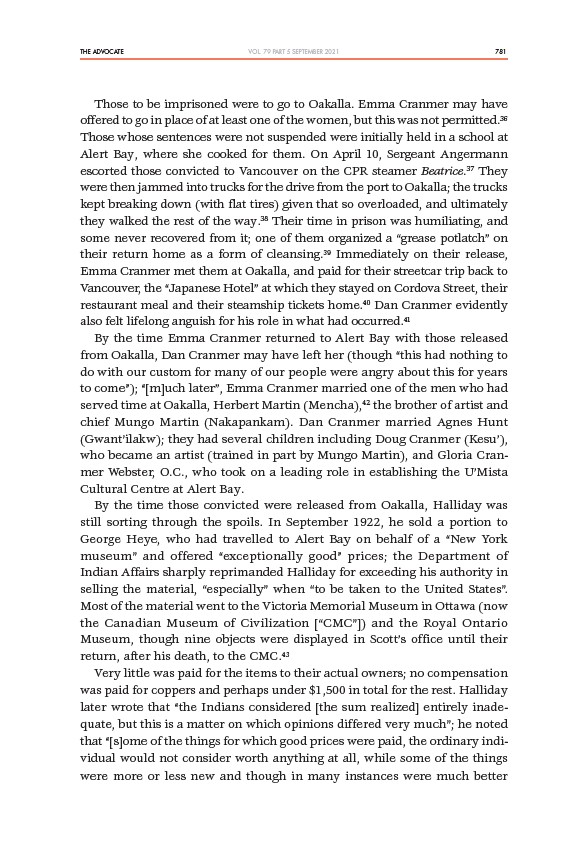
THE ADVOCATE 781
VOL. 79 PART 5 SEPTEMBER 2021
Those to be imprisoned were to go to Oakalla. Emma Cranmer may have
offered to go in place of at least one of the women, but this was not permitted.36
Those whose sentences were not suspended were initially held in a school at
Alert Bay, where she cooked for them. On April 10, Sergeant Angermann
escorted those convicted to Vancouver on the CPR steamer Beatrice.37 They
were then jammed into trucks for the drive from the port to Oakalla; the trucks
kept breaking down (with flat tires) given that so overloaded, and ultimately
they walked the rest of the way.38 Their time in prison was humiliating, and
some never recovered from it; one of them organized a “grease potlatch” on
their return home as a form of cleansing.39 Immediately on their release,
Emma Cranmer met them at Oakalla, and paid for their streetcar trip back to
Vancouver, the “Japanese Hotel” at which they stayed on Cordova Street, their
restaurant meal and their steamship tickets home.40 Dan Cranmer evidently
also felt lifelong anguish for his role in what had occurred.41
By the time Emma Cranmer returned to Alert Bay with those released
from Oakalla, Dan Cranmer may have left her (though “this had nothing to
do with our custom for many of our people were angry about this for years
to come”); “much later”, Emma Cranmer married one of the men who had
served time at Oakalla, Herbert Martin (Mencha),42 the brother of artist and
chief Mungo Martin (Nakapankam). Dan Cranmer married Agnes Hunt
(Gwant’ilakw); they had several children including Doug Cranmer (Kesu’),
who became an artist (trained in part by Mungo Martin), and Gloria Cranmer
Webster, O.C., who took on a leading role in establishing the U’Mista
Cultural Centre at Alert Bay.
By the time those convicted were released from Oakalla, Halliday was
still sorting through the spoils. In September 1922, he sold a portion to
George Heye, who had travelled to Alert Bay on behalf of a “New York
museum” and offered “exceptionally good” prices; the Department of
Indian Affairs sharply reprimanded Halliday for exceeding his authority in
selling the material, “especially” when “to be taken to the United States”.
Most of the material went to the Victoria Memorial Museum in Ottawa (now
the Canadian Museum of Civilization “CMC”) and the Royal Ontario
Museum, though nine objects were displayed in Scott’s office until their
return, after his death, to the CMC.43
Very little was paid for the items to their actual owners; no compensation
was paid for coppers and perhaps under $1,500 in total for the rest. Halliday
later wrote that “the Indians considered the sum realized entirely inadequate,
but this is a matter on which opinions differed very much”; he noted
that “some of the things for which good prices were paid, the ordinary individual
would not consider worth anything at all, while some of the things
were more or less new and though in many instances were much better